Mundong Mangyan: How Mindoro’s Alangan Mangyan face land disputes, lack of teachers, child marriages
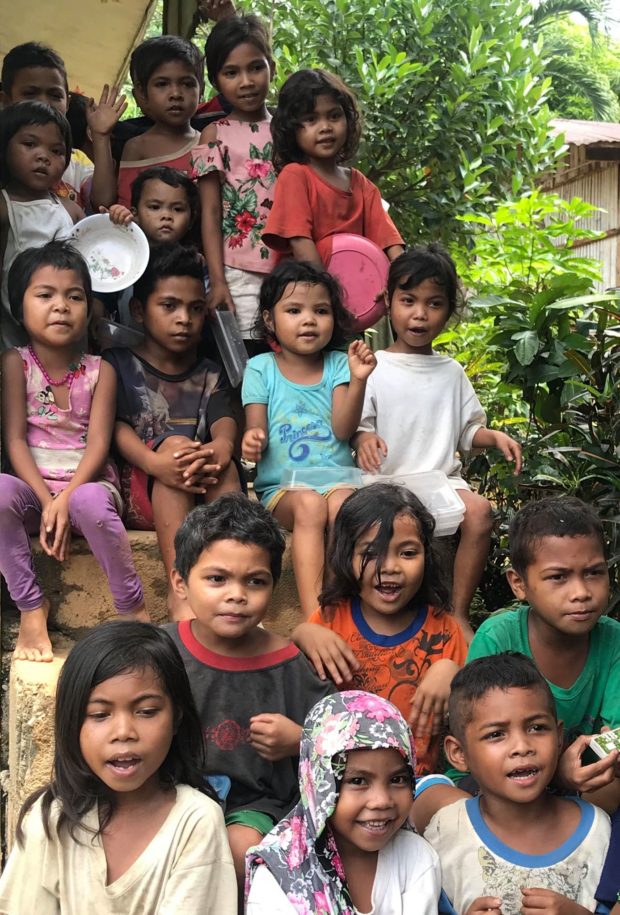
Alangan Mangyan kids. INQUIRER.net/Cody Cepeda
It took about two years into a job at a confectionery factory in Laguna before Crezel Leviste felt something was quite amiss. Her memory had started to fail her. She could no longer remember much of what she learned in college, and of the little she could, she realized these served no real purpose in the algorithmic grind of making yema day in and day out. It was the factory work, she said, that made her “dumb.”
Returning to her small Alangan Mangyan community at the foothill of Mt. Halcon in Baco, Oriental Mindoro, was not a difficult decision to make. The thought of the children convinced her to go back in 2018 and teach again.
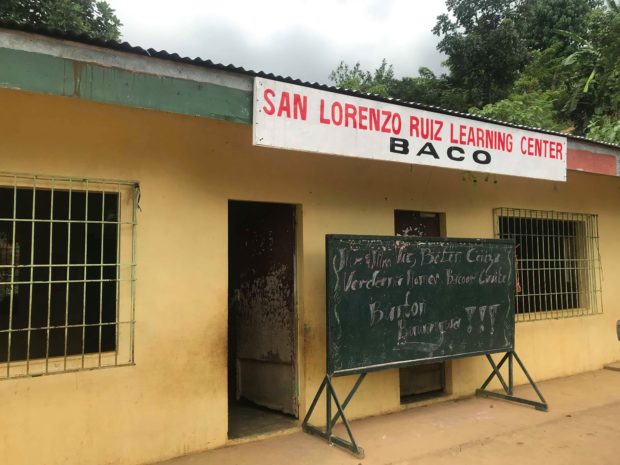
San Lorenzo Learning Center. INQUIRER.net/Cody Cepeda
She is one of the only two teachers at the San Lorenzo Ruiz Learning Center in San Ignacio Banilad, Dulangan III, handling the subjects home economics and Mangyan culture. There are about 96 students enrolled this school year from kindergarten to grade 6. It’s quite an overwhelming number for her and her co-teacher Laila, but they seemed to have made it work by taking turns throughout the day, Crezel managing grades 4 to 6 in the morning and switching with Laila in the afternoon for grades 1 to 3.
It would be nice to have a few more teachers to help around, as per Crezel. Perhaps two, or three more. Teachers do not last long in this learning center. They are usually new graduates looking to earn a year of service, a requirement needed so they can be allowed to take the board exams. The learning center can only pay P6,000 every month, with benefits, to teachers who are not board passers, but since none can commit to teach for two to three years, yearly teaching contracts are instead offered. These, coupled with the far distance of Sitio Banilad from Poblacion, and the fear toward the Alangan Mangyan community, are the reasons why Tagalog teachers from Calapan City are wary of working in the school.
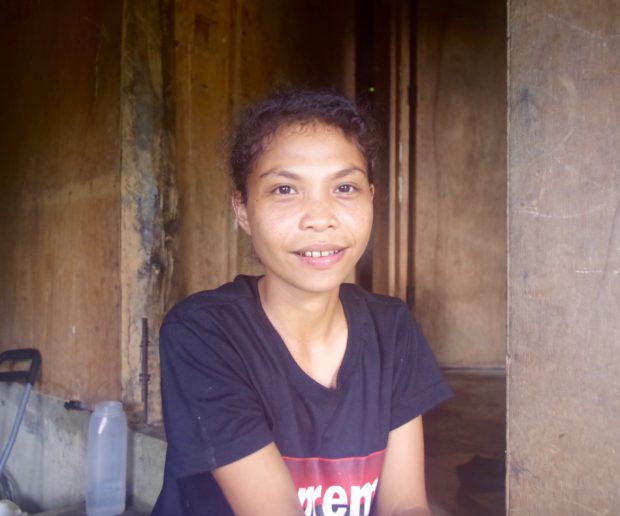
Crezel Leviste, teacher at San Lorenzo Ruiz Learning Center. INQUIRER.net/Cody Cepeda
Rosalina Valenton, who put up the learning center in the early 1990s as an extension school of the San Lorenzo Ruiz Academy in Calapan, has been encouraging Alangan Mangyans themselves to serve as its teachers. She first met the community in 1990 during a visit to monitor the flood situation in the area. She remembered seeing a lot of children when she arrived and discovered later on that they all have stopped attending public school after suffering from extreme discrimination.
Article continues after this advertisement“Ang mga bata ay umuuwi ng may suntok pagka hindi nila ibinibigay ang baon nila sa kaklaseng Tagalog,” Valenton said. “Kahit hindi daw sila ang may kasalanan, ang lumalabas ay sila daw ang may kasalanan dahil Mangyan nga sila. Hindi nila ma-express yung sarili nila.”
Article continues after this advertisement(The children go home with bruises from being punched when they do not turn over their lunch money to Tagalog classmates. Even when something is not their fault, they get the blame because they are Mangyan. They cannot express themselves.)
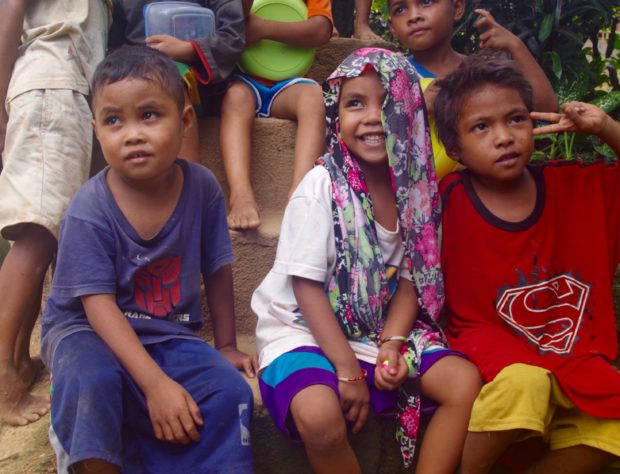
Alangan Mangyan children. INQUIRER.net/Cody Cepeda
Crezel is a scholar of the Buhay at Kinabukasan Development Foundation, the organization that manages the learning center. Now 29 years old, she was one of the many students Valenton took under her wing so she could pursue her studies at the Oriental Mindoro National High School in Calapan City. She entered the Divine Word College later on to take a Bachelor of Arts degree in Psychology and is just one semester away from becoming the first ever college graduate of their Alangan Mangyan community. She, however, has stopped attending.
Crezel is afraid of computers, said Valenton, and struggles to believe she could learn how to use one. And so, with her fear for the machine, Crezel decided to forego the last of her studies to work instead.
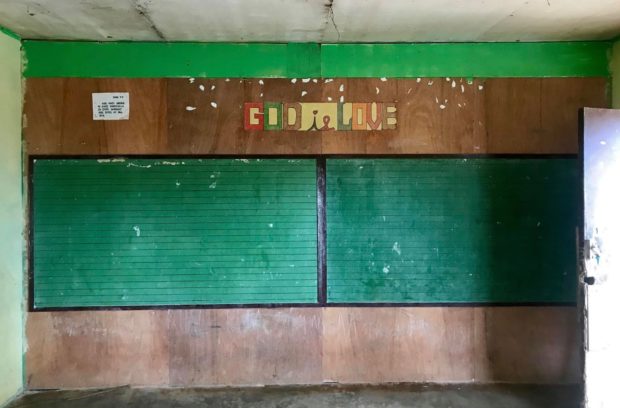
A classroom of San Lorenzo Ruiz Learning Center. INQUIRER.net/Cody Cepeda
Child marriage, lack of education
The operation of the learning center formally took flight in 1991 and opened its doors to 67 Alangan Mangyan students. It seemed like an ideal situation – here they had a school to call their own and where they would experience no prejudice from others who are not like them. But another problem pervading the community has hindered some students from attending school and finishing their education: child marriage.
Some Mangyan children are arranged into marriages as early as 10 years old, as per Valenton, a harsh reality brought on by extreme poverty. Marrying young is viewed as a transfer of responsibility for some families in the impoverished Alangan Mangyan community, an option for what they believe would be a better life that awaits them.
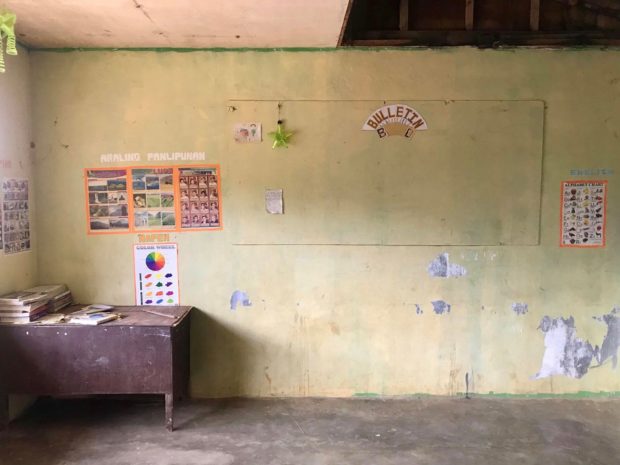
San Lorenzo Ruiz Learning Center. INQUIRER.net/Cody Cepeda
Dr. Melvin Jabar, an anthropologist and associate professor in the Behavioral Sciences Department of De La Salle University-Manila, has been involved with the Alangan Mangyans since 2006. He lamented that many young Mangyans would no longer pursue their education and would get married instead upon graduating from elementary.
“Baka sa kanila okay na ‘yun. Probably the idea of education is imposition para sa kanila because for them life can be like that, so medyo dilemma rin,” said Jabar. “So ‘yung reflection ko, namimilit ba tayo? But at the same time, access to education is a basic right, regardless kung IP ka or hindi.”
(Perhaps for them, it is ok. Probably the idea of education is imposition for them, because for them, life can be like that, so perhaps that is a bit of a dilemma. My reflection is that are we imposing on them? But at the same time, access to education is a basic right, regardless if you are from the indigenous peoples or not.)
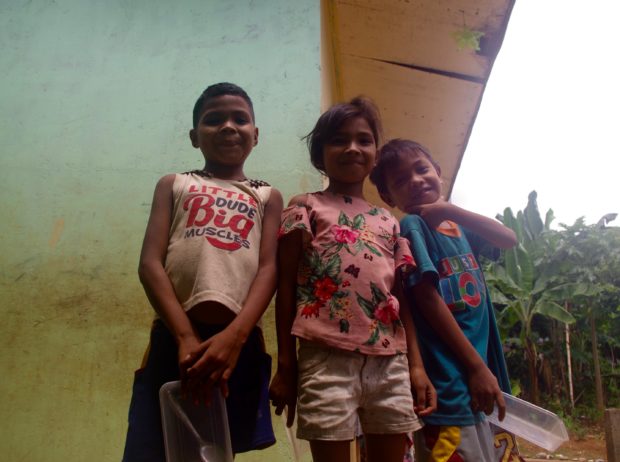
Alangan Mangyan children. iNQUIRER.net/Cody Cepeda
Despite the incidences of child marriage in the community, no initiatives from the local government unit or non-government organizations to address it has been introduced, as per Valenton. It only started to change in the past five years when the Alangan Mangyans themselves realized no good would come from marrying young.
Crezel herself had two female students of her own who suddenly up and left school to get married in 2014. One was in grade 5, the other in grade 3, and both just stopped attending class one day. The former has since given birth to a child. Regret inevitably followed.
“Para po akong nasasayangan, nanghihinayang. Nakakaawa,” said Crezel. “Minsan sinasabi ko naman sa kanila, pero pagka sila din naman po, nagsasabi, ‘Oo nga po, talagang kami po’y nagsisisi rin.’ Ganun po nangyari.”
(I feel as if it is such a loss. I pity them. Sometimes I do warn them. Sometimes they themselves express their regret. “Yes, we really do regret it.” That is what happens.)
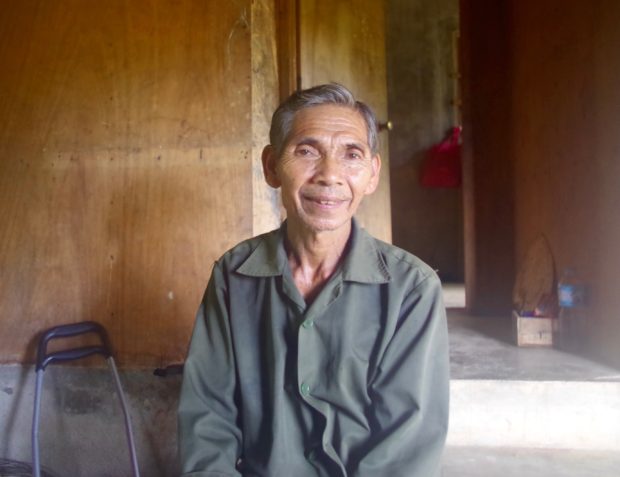
Brgy. Capt. Pinoy “Kap” Oscado. INQUIRER.net/Cody Cepeda
Pinoy Oscado, fondly known as Kap, served as barangay captain in the area for 10 years in the 1990s. His own 14-year-old daughter left their home to elope with an 18-year-old boy during his time as barangay captain. He remembers going to the police and the Department of Social Welfare and Development (DSWD) for help, but his pleas fell on deaf ears.
He recalled DSWD telling him nothing can be done if his daughter was not forced to go with the young man. If it was her decision, then what is it to him?
“‘Pagka tinanong natin ay hindi siya sinapilitan at siya ang may gusto, ang anak mong babae, ay pasensya ka. Siya may gusto eh, anong kinalaman mo dun?’ Sabing ganun,” said Kap. “Aba! Eh pwede pala na gayon ‘yun. E di baliktad,’ sabi ko. ‘Baliktad ‘yun. Hindi ang bata ang masusunod!’ Eh, wala nga tayo magagawa pagka sila ang may gusto.”
(They told me there is nothing I can do since it is my daughter who wanted to elope. I asked how can that be, it should be the other way around, because a child cannot decide for herself. They insisted we cannot do anything if it is the children who want it.)
The 59-year-old Kap is one of the leaders in the community along with Ademar Leviste, Crezel’s father. Both haven’t finished their education, but recognize its importance. For Ademar, he is happy knowing two of his six children have at least reached college. He only finished grade 6 himself and was just 18 years old when he married his wife, who was 16 years old.
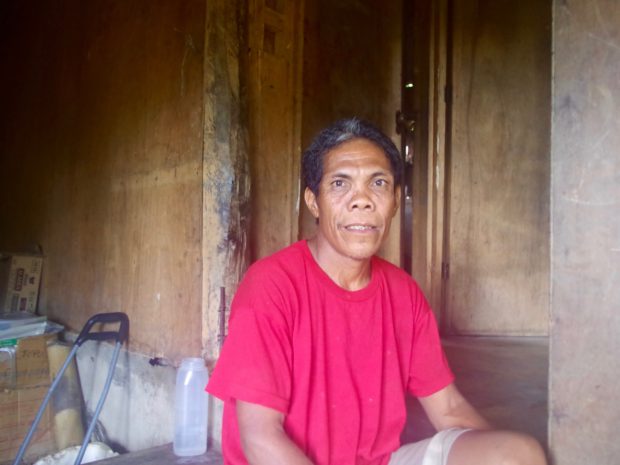
Ka Ademar Leviste. INQUIRER.net/Cody Cepeda
It is a good thing to study and finish something, he said, as he hopes his children do not take after him and his wife.
“Tuwang-tuwa po ako na nag-aaral ang aking panganay. Kahit isang kain isang tuka, minsan wala pa, nagagawan namin ng paraan na maresolba lahat ng pangangailangan ng mga anak ko,” said Ademar. “Kami pong mga katutubo sa lugar na ito, mahirap din ang buhay. Para na din sa akin, ang tanda para umasenso [at] umunlad ang isang pamilya [ay] yung magtapos ng pagaaral.”
(I am so happy that my eldest is studying. Although we live in poverty, we are able to find ways to supply her with her school needs. We, the indigenous people here, live hard lives. For old people like me, it may already be too late to rise from poverty, but the family still can, if the chiildren can finish school.)
Some parents in the community would pull out their own children from school so they can help in earning money for the family. The children would attend classes for a few times, disappear for months and then return when it is almost Christmastime. These students often end up repeating years due to their drawn-out truancy.
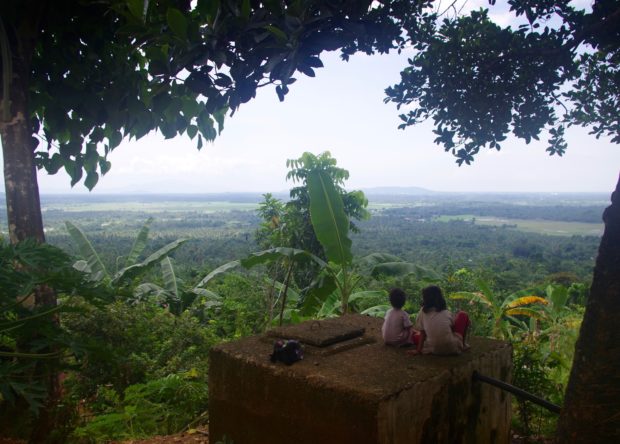
View from water tank, Mt. Halcon foothill. INQUIRER.net/Cody Cepeda
Of disputed lands and Mt. Halcon
Mt. Halcon is home to varied and unique flora and fauna, as well as to two of the eight ethnolinguistic groups in Mindoro, the Alangan Mangyan and the Iraya Mangyan. Mt. Halcon is considered an ancestral domain of the Mangyans and is known to them as “Siyaldang” or Sacred Mountain, as per the Mount Halcon Conservation and Management Plan in 2012. The mountain, however, has been susceptible to anthropogenic disturbances throughout the years, due in part to a lack of conservation efforts from different sectors and there being no unified plan for the area.
Mt. Halcon is covered by Certificate of Ancestral Domain Title (CADT) applications of both the Alangan and Iraya Mangyans. According to The Indigenous Peoples Rights Act of 1997, a CADT formally recognizes the rights of possession and ownership of indigenous cultural communities or indigenous peoples over their ancestral domains. Ancestral domains refer to areas belonging to indigenous peoples and comprise lands, inland waters, coastal areas and natural resources. These include concepts of territories not just in regard to the physical environment, but also the total environment. These in turn span the spiritual and cultural bonds of the indigenous peoples to the area they occupy and use, and to which they have claims of ownership.
For the Alangan Mangyans, no word is more powerful than “land.” However, a CADT has yet to be awarded to their small Alangan Mangyan community, as per Jabar, and more of their lands are at risk of being grabbed due to the lack of it.
A portion of the Alangan Mangyans’ lands, where the learning center now stands, has already been bought back by the Buhay at Kinabukasan Development Foundation from the Tagalogs, said Valenton. They have converted some of the land into a farm and are looking into building an agricultural school for the community.
Ademar meanwhile asserted that the mountain belongs to the Mangyans and no one should set foot in it without consulting the elders of the ethnolinguistic groups.
“Ang kabundukan ay sa pag-aari ng mga katutubo at walang dapat na pumasok diyan na kahit na sino ng hindi nakikipagugnayan sa mga matatandang katutubo na nakakasakop ng lugar,” said Ademar. “Sa kasalukuyan meron kaming usapin sa lupain na matagal nang inagaw ng mga kapatagan, yun ay mga lupa ng katutubo. Inagaw lang sa amin. Kapag may sarili nang tumutulong na abogado, maaari na naming ipaglaban kahit na papaano.”
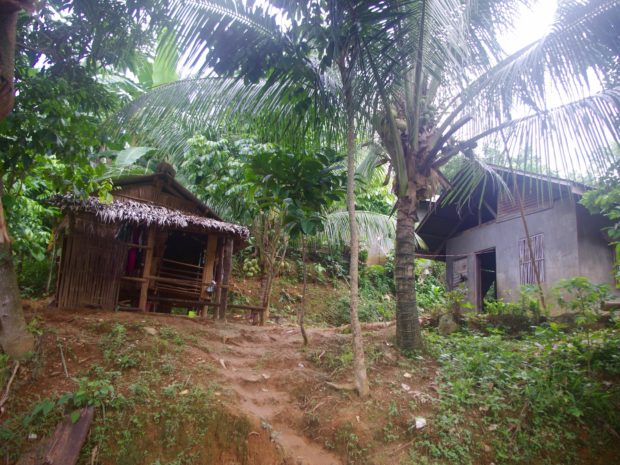
Mangyan houses. INQUIRER.net/Cody Cepeda
(Presently, we have a land dispute, over land which was taken away by people from the lowlands. Those are land belonging to the natives. It was just taken away from us. When we get a lawyer who can help us, we can already fight for it, somehow.)
The Mangyan communities in Oriental Mindoro have been riddled with fear and angst as of late due to the construction of hydroelectric power projects in their areas. Some Mangyan elders and village leaders have spoken to environment secretary Roy Cimatu last August 2018 and requested to order the suspension of Santa Clara International Corporation’s (SCIC) environmental compliance certificate (ECC).
According to the Mangyans from Baco, Naujan and Victoria, SCIC allegedly used dynamites to create a tunnel within mountain slopes in the 3,000-hectare project site, which could collapse during heavy rains. Unusual floodings have hit their villages and destroyed their crops and livestock, which they believe were caused by the hydroelectric power project. The Mangyans claimed then that SCIC disregarded an agreement with Mangyan leaders from three different barangays. The agreement was supposedly about not using blasting in the project. It was reported at the time that SCIC had 13 hydroelectric power projects planned in a joint venture with Union Energy.
The hydropower plant projects being built are quite far from the Alangan Mangyan community in Banilad, said Ademar, but this does not mean they are safe from its possible injurious effects.
“Yun po ay sakop ng bayan ng San Teodoro, pero may ilog na nanggaling dun sa electrical power ng hydro,” he said. “Yung ilog, laging labo, tapos kapag bumaha, ang pinakamalaki salanta yung Baco. Diretso po [yang usapin], pero ewan ko lang sa mga bagong nanalong congressman kung paano nila gagawan ng paraan magtigil dun ang planta na ‘yan.”
(That is withing the town of San Teodoro, but there is a river that comes from [the hyrdro]. It is always murky, and when it floods, Baco is the most damaged. Dialogues are on-going but I do not know about the newly-elected congressmen, how they can stop that plant there.)
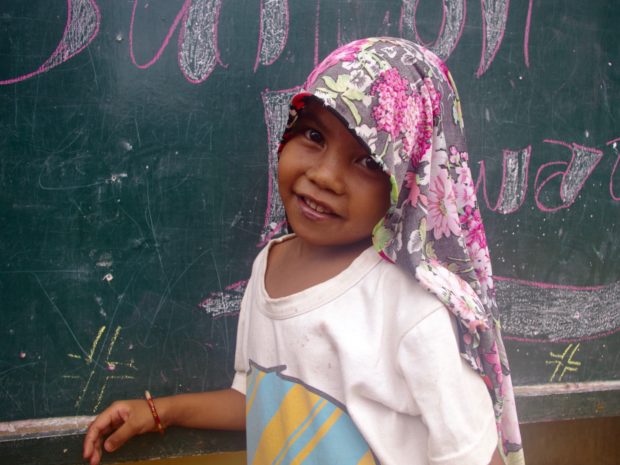
An Alangan Mangyan child. INQUIRER.net/Cody Cepeda
A striving people
There are, give or take, 90 households in the Alangan Mangyan community in Sitio Banilad. Through the years, it has found itself back to the initial point time and again. Farming, in itself, is as fickle as it is seasonal when at the mercy of natural disasters. Due to this, the community in the past couple of years started to open itself up to other livelihood pursuits that have the potential to help them get by. These include making bead accessories, working in construction and as tour guides to mountaineers, building bed frames and instruments out of wood, and crafting lanterns out of plastic bottles — anything that could somehow help assuage the precariousness of their situation. And still, they are not asking for much.
“Ang mahalaga sa amin, ‘yung hindi dapat balewalain ang aming kultura at ang mga dayuhan ay matutong gumalang kung sino kami. Dahil kung sa amin, bilang katutubong Alangan Mangyan, lahat ay kaibigan,” said Ademar. “Kung iniisip ng mga mayayaman na kami ay maliit lang, basta sa amin, pantay-pantay lang. Respeto. Bigyan ng galang ang aming kultura at ang aming pagkatao dahil kami po ay tao rin na kagaya nila.”
(What is important to us is for our culture not to be neglected, and for foreigners and visitors to be respectful of who we are. To us Alangan Mangyan, everyone is a friend. If the rich think we are small, as for us, everyone is equal. Respect. Respect our culture and our humanity, because we are also human beings like them.)
From outside the learning center, a young girl sat under a tree. Her name is Gelyn and she almost looked inconsequential juxtaposed with the sacred Mt. Halcon that loomed just behind her. She wanted to know if Manila is beautiful, if those who lived there watched television just the same. She was told once it was all roads and no trees, and wondered if there were fruit in the city. She seemed unbelieving people paid for water there.
“Dito, libre.” JB
RELATED STORIES:
DENR hears out Mangyan gripes over 13 hydro projects
From 24/7 service to ‘estero-telling’: Checking up on the state of public libraries